Dongdong Zhang
VisCodex: Unified Multimodal Code Generation via Merging Vision and Coding Models
Aug 13, 2025Abstract:Multimodal large language models (MLLMs) have significantly advanced the integration of visual and textual understanding. However, their ability to generate code from multimodal inputs remains limited. In this work, we introduce VisCodex, a unified framework that seamlessly merges vision and coding language models to empower MLLMs with strong multimodal code generation abilities. Leveraging a task vector-based model merging technique, we integrate a state-of-the-art coding LLM into a strong vision-language backbone, while preserving both visual comprehension and advanced coding skills. To support training and evaluation, we introduce the Multimodal Coding Dataset (MCD), a large-scale and diverse collection of 598k samples, including high-quality HTML code, chart image-code pairs, image-augmented StackOverflow QA, and algorithmic problems. Furthermore, we propose InfiBench-V, a novel and challenging benchmark specifically designed to assess models on visually-rich, real-world programming questions that demand a nuanced understanding of both textual and visual contexts. Extensive experiments show that VisCodex achieves state-of-the-art performance among open-source MLLMs and approaches proprietary models like GPT-4o, highlighting the effectiveness of our model merging strategy and new datasets.
Scaling Laws of Synthetic Data for Language Models
Mar 26, 2025



Abstract:Large language models (LLMs) achieve strong performance across diverse tasks, largely driven by high-quality web data used in pre-training. However, recent studies indicate this data source is rapidly depleting. Synthetic data emerges as a promising alternative, but it remains unclear whether synthetic datasets exhibit predictable scalability comparable to raw pre-training data. In this work, we systematically investigate the scaling laws of synthetic data by introducing SynthLLM, a scalable framework that transforms pre-training corpora into diverse, high-quality synthetic datasets. Our approach achieves this by automatically extracting and recombining high-level concepts across multiple documents using a graph algorithm. Key findings from our extensive mathematical experiments on SynthLLM include: (1) SynthLLM generates synthetic data that reliably adheres to the rectified scaling law across various model sizes; (2) Performance improvements plateau near 300B tokens; and (3) Larger models approach optimal performance with fewer training tokens. For instance, an 8B model peaks at 1T tokens, while a 3B model requires 4T. Moreover, comparisons with existing synthetic data generation and augmentation methods demonstrate that SynthLLM achieves superior performance and scalability. Our findings highlight synthetic data as a scalable and reliable alternative to organic pre-training corpora, offering a viable path toward continued improvement in model performance.
Chain-of-Reasoning: Towards Unified Mathematical Reasoning in Large Language Models via a Multi-Paradigm Perspective
Jan 19, 2025Abstract:Large Language Models (LLMs) have made notable progress in mathematical reasoning, yet they often rely on single-paradigm reasoning that limits their effectiveness across diverse tasks. In this paper, we introduce Chain-of-Reasoning (CoR), a novel unified framework that integrates multiple reasoning paradigms--Natural Language Reasoning (NLR), Algorithmic Reasoning (AR), and Symbolic Reasoning (SR)--to enable synergistic collaboration. CoR generates multiple potential answers using different reasoning paradigms and synthesizes them into a coherent final solution. We propose a Progressive Paradigm Training (PPT) strategy that allows models to progressively master these paradigms, culminating in the development of CoR-Math-7B. Experimental results demonstrate that CoR-Math-7B significantly outperforms current SOTA models, achieving up to a 41.0% absolute improvement over GPT-4 in theorem proving tasks and a 7.9% improvement over RL-based methods in arithmetic tasks. These results showcase the enhanced mathematical comprehensive ability of our model, achieving significant performance gains on specific tasks and enabling zero-shot generalization across tasks.
ShifCon: Enhancing Non-Dominant Language Capabilities with a Shift-based Contrastive Framework
Oct 25, 2024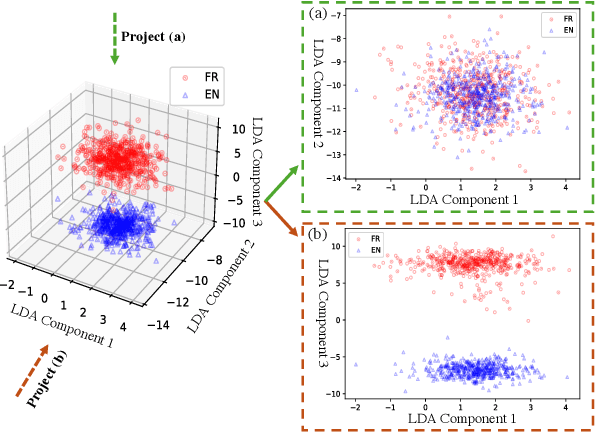
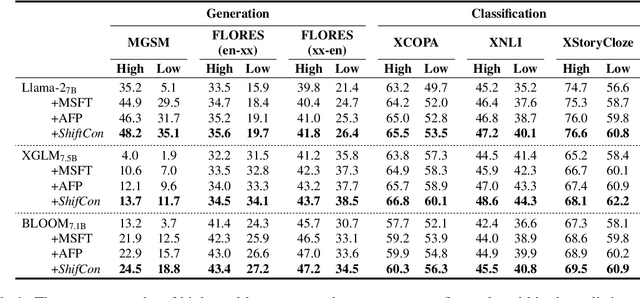
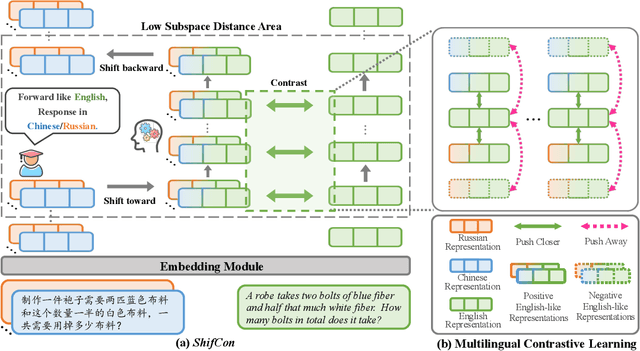
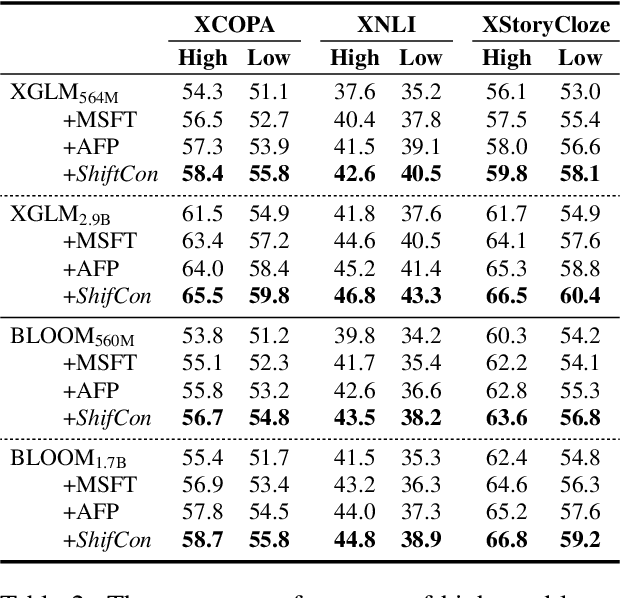
Abstract:Although fine-tuning Large Language Models (LLMs) with multilingual data can rapidly enhance the multilingual capabilities of LLMs, they still exhibit a performance gap between the dominant language (e.g., English) and non-dominant ones due to the imbalance of training data across languages. To further enhance the performance of non-dominant languages, we propose ShifCon, a Shift-based Contrastive framework that aligns the internal forward process of other languages toward that of the dominant one. Specifically, it shifts the representations of non-dominant languages into the dominant language subspace, allowing them to access relatively rich information encoded in the model parameters. The enriched representations are then shifted back into their original language subspace before generation. Moreover, we introduce a subspace distance metric to pinpoint the optimal layer area for shifting representations and employ multilingual contrastive learning to further enhance the alignment of representations within this area. Experiments demonstrate that our ShifCon framework significantly enhances the performance of non-dominant languages, particularly for low-resource ones. Further analysis offers extra insights to verify the effectiveness of ShifCon and propel future research
Language-Specific Neurons: The Key to Multilingual Capabilities in Large Language Models
Feb 26, 2024



Abstract:Large language models (LLMs) demonstrate remarkable multilingual capabilities without being pre-trained on specially curated multilingual parallel corpora. It remains a challenging problem to explain the underlying mechanisms by which LLMs process multilingual texts. In this paper, we delve into the composition of Transformer architectures in LLMs to pinpoint language-specific regions. Specially, we propose a novel detection method, language activation probability entropy (LAPE), to identify language-specific neurons within LLMs. Based on LAPE, we conduct comprehensive experiments on two representative LLMs, namely LLaMA-2 and BLOOM. Our findings indicate that LLMs' proficiency in processing a particular language is predominantly due to a small subset of neurons, primarily situated in the models' top and bottom layers. Furthermore, we showcase the feasibility to "steer" the output language of LLMs by selectively activating or deactivating language-specific neurons. Our research provides important evidence to the understanding and exploration of the multilingual capabilities of LLMs.
Synthetic Data (Almost) from Scratch: Generalized Instruction Tuning for Language Models
Feb 20, 2024Abstract:We introduce Generalized Instruction Tuning (called GLAN), a general and scalable method for instruction tuning of Large Language Models (LLMs). Unlike prior work that relies on seed examples or existing datasets to construct instruction tuning data, GLAN exclusively utilizes a pre-curated taxonomy of human knowledge and capabilities as input and generates large-scale synthetic instruction data across all disciplines. Specifically, inspired by the systematic structure in human education system, we build the taxonomy by decomposing human knowledge and capabilities to various fields, sub-fields and ultimately, distinct disciplines semi-automatically, facilitated by LLMs. Subsequently, we generate a comprehensive list of subjects for every discipline and proceed to design a syllabus tailored to each subject, again utilizing LLMs. With the fine-grained key concepts detailed in every class session of the syllabus, we are able to generate diverse instructions with a broad coverage across the entire spectrum of human knowledge and skills. Extensive experiments on large language models (e.g., Mistral) demonstrate that GLAN excels in multiple dimensions from mathematical reasoning, coding, academic exams, logical reasoning to general instruction following without using task-specific training data of these tasks. In addition, GLAN allows for easy customization and new fields or skills can be added by simply incorporating a new node into our taxonomy.
One-stop Training of Multiple Capacity Models
May 24, 2023



Abstract:Training models with varying capacities can be advantageous for deploying them in different scenarios. While high-capacity models offer better performance, low-capacity models require fewer computing resources for training and inference. In this work, we propose a novel one-stop training framework to jointly train high-capacity and low-capactiy models. This framework consists of two composite model architectures and a joint training algorithm called Two-Stage Joint-Training (TSJT). Unlike knowledge distillation, where multiple capacity models are trained from scratch separately, our approach integrates supervisions from different capacity models simultaneously, leading to faster and more efficient convergence. Extensive experiments on the multilingual machine translation benchmark WMT10 show that our method outperforms low-capacity baseline models and achieves comparable or better performance on high-capacity models. Notably, the analysis demonstrates that our method significantly influences the initial training process, leading to more efficient convergence and superior solutions.
Chain-of-Dictionary Prompting Elicits Translation in Large Language Models
May 24, 2023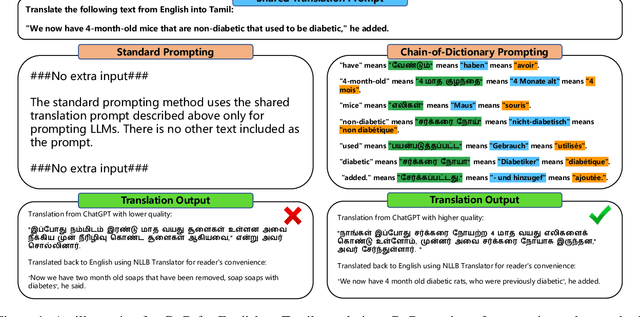


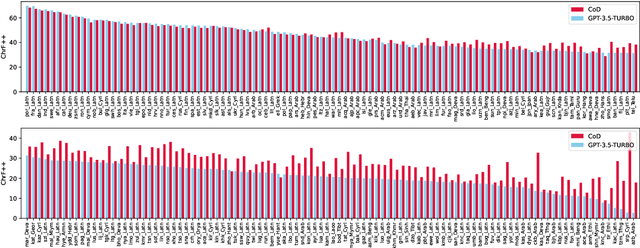
Abstract:Large language models (LLMs) have shown surprisingly good performance in multilingual neural machine translation (MNMT) even when trained without parallel data. Yet, despite the fact that the amount of training data is gigantic, they still struggle with translating rare words, particularly for low-resource languages. Even worse, it is usually unrealistic to retrieve relevant demonstrations for in-context learning with low-resource languages on LLMs, which restricts the practical use of LLMs for translation -- how should we mitigate this problem? To this end, we present a novel method, CoD, which augments LLMs with prior knowledge with the chains of multilingual dictionaries for a subset of input words to elicit translation abilities for LLMs. Extensive experiments indicate that augmenting ChatGPT with CoD elicits large gains by up to 13x chrF++ points for MNMT (3.08 to 42.63 for English to Serbian written in Cyrillic script) on FLORES-200 full devtest set. We further demonstrate the importance of chaining the multilingual dictionaries, as well as the superiority of CoD to few-shot demonstration for low-resource languages.
Not All Metrics Are Guilty: Improving NLG Evaluation with LLM Paraphrasing
May 24, 2023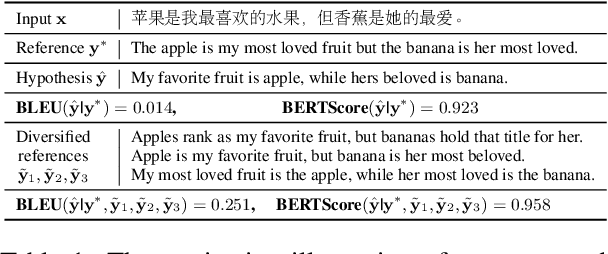
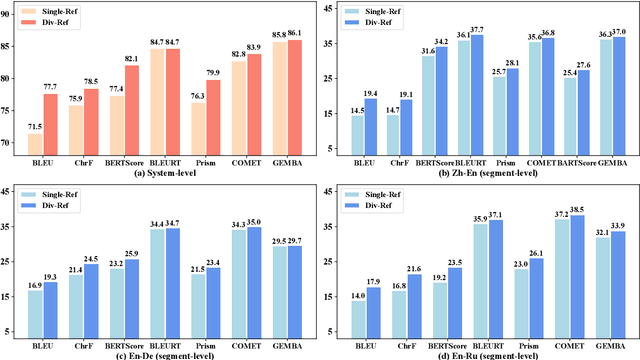

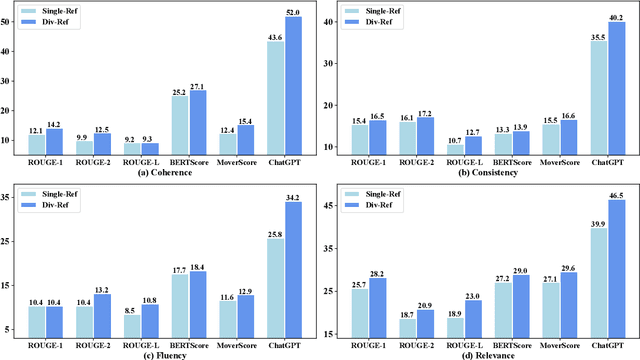
Abstract:Most research about natural language generation (NLG) relies on evaluation benchmarks with limited references for a sample, which may result in poor correlations with human judgements. The underlying reason is that one semantic meaning can actually be expressed in different forms, and the evaluation with a single or few references may not accurately reflect the quality of the model's hypotheses. To address this issue, this paper presents a novel method, named Para-Ref, to enhance existing evaluation benchmarks by enriching the number of references. We leverage large language models (LLMs) to paraphrase a single reference into multiple high-quality ones in diverse expressions. Experimental results on representative NLG tasks of machine translation, text summarization, and image caption demonstrate that our method can effectively improve the correlation with human evaluation for sixteen automatic evaluation metrics by +7.82% in ratio. We release the code and data at https://github.com/RUCAIBox/Para-Ref.
Target-Agnostic Gender-Aware Contrastive Learning for Mitigating Bias in Multilingual Machine Translation
May 23, 2023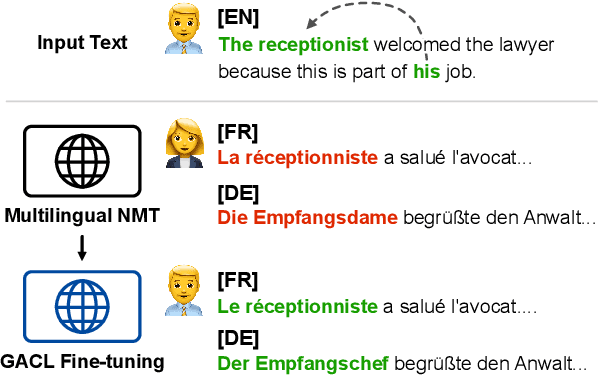



Abstract:Gender bias is a significant issue in machine translation, leading to ongoing research efforts in developing bias mitigation techniques. However, most works focus on debiasing of bilingual models without consideration for multilingual systems. In this paper, we specifically target the unambiguous gender bias issue of multilingual machine translation models and propose a new mitigation method based on a novel perspective on the problem. We hypothesize that the gender bias in unambiguous settings is due to the lack of gender information encoded into the non-explicit gender words and devise a scheme to encode correct gender information into their latent embeddings. Specifically, we employ Gender-Aware Contrastive Learning, GACL, based on gender pseudo-labels to encode gender information on the encoder embeddings. Our method is target-language-agnostic and applicable to already trained multilingual machine translation models through post-fine-tuning. Through multilingual evaluation, we show that our approach improves gender accuracy by a wide margin without hampering translation performance. We also observe that incorporated gender information transfers and benefits other target languages regarding gender accuracy. Finally, we demonstrate that our method is applicable and beneficial to models of various sizes.
 Add to Chrome
Add to Chrome Add to Firefox
Add to Firefox Add to Edge
Add to Edge